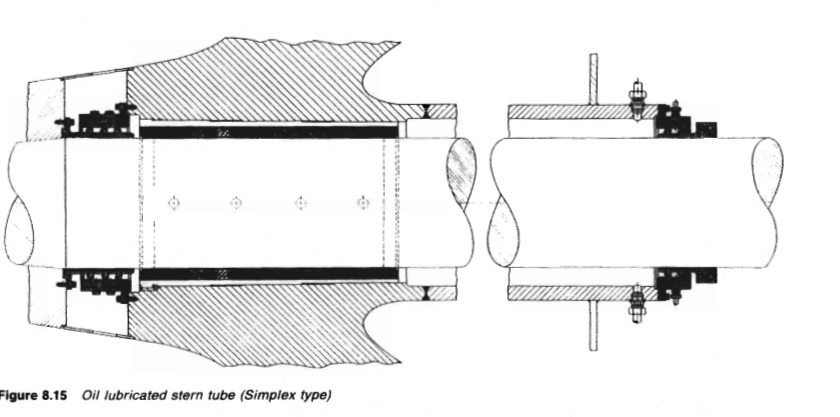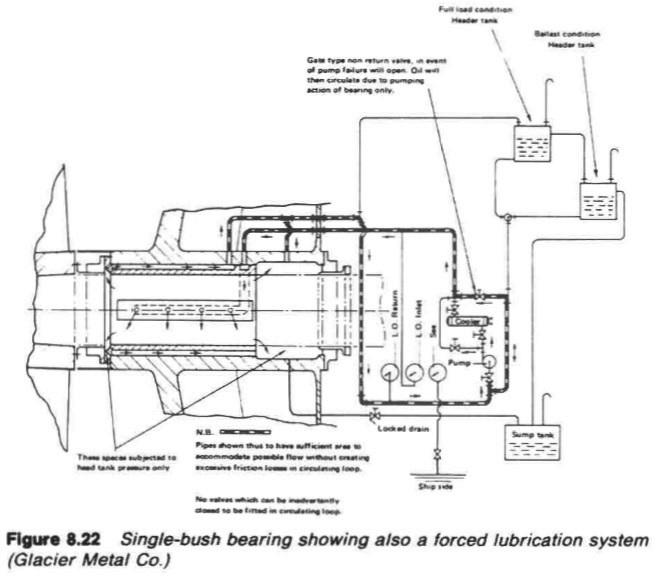
Home page||Propeller shaft ||
Stern tube Lubrication systems- Oil-lubricated stern tubes
Oil-lubricated stern tubes
Progress from sea-water to early oil-lubricated stern tubes involved an
exchange of the wooden bearing in its bronze sleeve for a white metal
lined cast iron (or sometimes bronze) bush. Oil retention and exclusion of
sea water necessitated the fitting of an external face type seal. The stuffing
box was retained in many early oil-lubricated stern tubes, at the inboard
end. In oil-lubricated bearings the shaft does not require a full length
protective bronze sleeve.
Simplex type stern tube
The later designs of oil-lubricated stern tube (Figure 8.15) are fitted in a stern
frame with an elongated boss to provide better support for the white metal
lined bearing. A minimum bearing length of two times shaft diameter will
ensure that bearing load does not exceed 0.8 N/mm2 (116 lbf/in2). The bearing
bush is normally grey or nodular cast iron centrifugally lined with white metal.
A typical analysis of white metal would be 3% copper, 7.5% antimony and the
remainder tin. White metal thicknesses vary according to the classification
society. Figures of 3.8 mm for a shaft of 300 mm diameter to 7.4 mm for a
900mm diameter shaft have been quoted, with bearing clearances of
0.51-0.63 mm and 1.53-1.89 mm respectively.
The forward part of the stern tube is fabricated and welded direct to the
extension of the stern frame boss and into the aft peak bulkhead.
Oil pressure within the stern tube is maintained at approximately the
same level as that of the surrounding sea water by a header tank. Oil is
contained within the Simplex type stem tube by lip seals. The elastic lip of
each nitrile rubber seal, grips a rubbing surface provided by short chrome
steel liners at outboard and inboard ends of the steel propeller shaft. The
outboard liner additionally protects the steel shaft from sea-water contact
and corrosion.
Heat produced by the friction will result in hardening and loss of elasticity of
the rubber, should temperature of the seal material exceed 110°C. Cooling at
the outboard end is provided by the sea. Inboard seals, unlike those at the
outboard end, cannot dissipate heat to the surrounding water. Oil circulation
aided by convection, is arranged to maintain the low temperature of the seals at
the inboard end. Connections for circulation, are fitted top and bottom
between the two inboard seals and the small local header tank.
The chrome liners act as rubbing surfaces for the rubber lip seals but
grooving from frictional wear has been a problem. The difficulty has been
overcome by using a ceramic filler for the groove or alternatively a distance
piece to displace axially the seal and ring assembly. Allowance must be made
for the relative movement of shaft and stern tube due to differential expansion.
New seals are fitted by cutting and vulcanizing in position.

Figure 8.15 Oil lubricated stern tube (Simplex type)
The static lubrication system for vessels with moderate changes in draught,
have header tanks placed 2—3 m above the maximum load waterline. The small
differential pressure ensures that water is excluded. The cooling of simple stern
tubes, necessitates keeping the aft peak water level at least 1 rrt above the stern
tube.
Tankers and other ships with large changes in draught, may be fitted with
two oil header tanks (Figure 8,22) for either the fully loaded or ballast condition.

Figure 8.22 Single-bush bearing showing also a forced lubrication system (Glacier Metal Co.)
Hydrodynamic or hydrostatic lubrication
The requirement for steaming at a slow, economical speed during periods of
high fuel prices (or for other reasons) gives a lower fluid film or hydrodynamic
pressure in stem tubes, due to the slower speed. The possibility of bearing
damage occurring prompted the installation of forced lubrication systems to
provide a hydrostatic pressure which is independent of shaft speed. The
supplied oil pressure gives adequate lift to separate shaft and bearing and an
adequate oil flow for cooling.
Summarized below some of the basic procedure of marine propeller shaft :
- Propeller shaft materials and couplings
The intermediate shafting and the propeller shaft for a fixed propeller are of
solid forged ingot steel and usually with solid forged couplings. Shafts are
machined all over but of a larger diameter and smooth turned in way of the
bearings.
......
- Fixed pitch propeller
The normal method of manufacture for a fixed pitch propeller, is to cast the blades integral with the boss and after inspection and marking, to machine the
tapered bore and faces of the boss before the blades are profiled by hand with reference to datum grooves cut in the surfaces or with an electronically controlled profiling machine.
......
- Controllable pitch propeller
Controllable pitch propellers are normally fitted to a flanged tailshaft as the operating mechanism is housed in the propeller boss. As its name implies, it is possible to alter the pitch of this type of propeller to change ship speed or to adjust to the prevailing resistance conditions.
......
- Propeller thrust block
The main thrust block transfers forward or astern propeller
thrust to the hull and limits axial movement of the shaft. Some axial clearance is essential to
allow formation of an oil film in the wedge shape between the collar and the
thrust pads
......
- Propeller shaft gears and clutches
For medium-speed engine installations in large ships (as opposed to coasters or intermediate sized vessels) reduction gears are needed to permit engines and propellers to run at their best respective speeds. Their use also permits more than one engine to be coupled to the same propeller. Gearboxes are available from manufacturers in standard sizes.
......
- Propeller shaft check
The intention of good alignment is to ensure that bearings are correctly loaded
and that the shaft is not severely stressed. Alignment can be checked with
conventional methods, employing light and targets, laser or measurements
from a taut wire.
......
- Propeller shaft bearings check
The intermediate shafting between the tailshaft and main engine,
gearbox or thrustblock may be supported in plain, tilting pad or roller bearings.
......
- Oil lubricated stern tube
Progress from sea-water to early oil-lubricated stern tubes involved an
exchange of the wooden bearing in its bronze sleeve for a white metal
lined cast iron (or sometimes bronze) bush. Oil retention and exclusion of
sea water necessitated the fitting of an external face type seal.
......
- Water lubricated stern tube
The traditional stern bearing is water-lubricated and consists of a
number of lignum vitae staves held by bronze retaining strips, in a gunmetal
bush. Lignum vitae is a hardwood with good wear characteristics and is
compatible with water.
......
- Stern tube sealing arrangement
There are basically three sealing arrangements used for stern bearings. These are:
Simple stuffing boxes filled with proprietary packing material. Lip seals, in which a number of flexible membranes in contact with the
shaft, prevent the passage of fluid along the shaft.
& Radial face seals, in which a wear-resistant face fitted radially around the
shaft,
......
- Stern tube bearings
To avoid the necessity for drydocking when an examination of stern bearings
amid tailshaft is needed, split stern bearings were developed. A suitable
outboard sealing arrangement and design, permits the two halves of the
bearing to be drawn into the ship, exposing the shaft and the white metal
bearing.
......
Home page||Cooling ||Machinery||Services ||Valves ||Pumps ||Auxiliary Power ||Propeller shaft ||Steering gears ||Ship stabilizers||Refrigeration||Air conditioning ||Deck machinery||Fire protection||Ship design
||Home ||
General Cargo Ship.com provide information on cargo ships various machinery systems -handling procedures, on board safety measures and some basic knowledge of cargo ships that might be useful for people working on board and those who working in the terminal. For any remarks please
Contact us
Copyright © 2010-2016 General Cargo Ship.com All rights reserved.
Terms and conditions of use
Read our privacy policy|| Home page||

